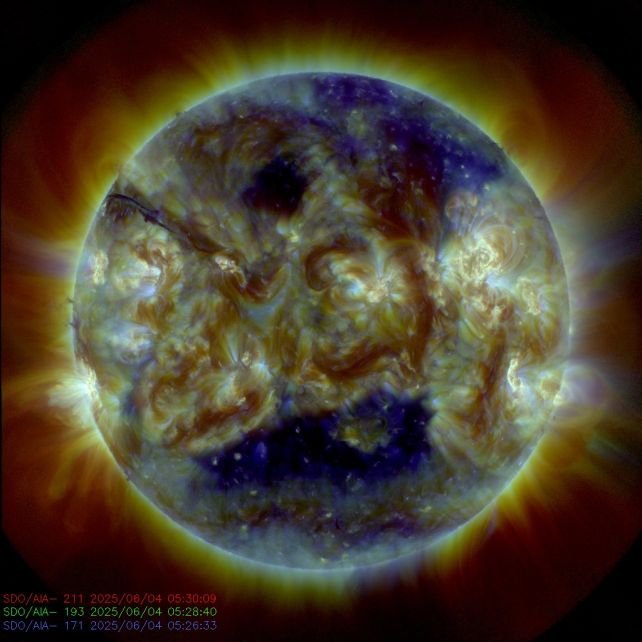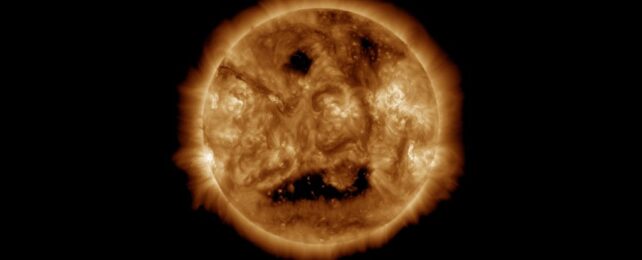A giant mouth-like hole in the Sun about as wide as five Jupiters is blasting hot Sun breath in Earth's general direction.
It's not an actual hole in the Sun, but what is known as a coronal hole: a region where the Sun's magnetic field opens up, allowing the wind of solar particles constantly blowing from our Sun to escape more readily, sending a gust of material blasting through the Solar System.
If you look at the Sun in optical wavelengths (we don't recommend doing this without special equipment), you won't notice anything; but, because these regions are cooler and less dense than the surrounding plasma, if you look at them in ultraviolet light, they appear as large, void-like patches of darkness.

Currently, the configuration of coronal holes on the face of the Sun is, well, exactly like that: a screaming face with a wide, mouth-like gash on the southern hemisphere, and two eye-like spots on the north.
Of course, they are much more impressive than normal eyes. Each of those northern 'dots' is around the size of Jupiter alone. And all three regions are blasting the Solar System with particles and plasma.
This is nothing to worry about, even though the Sun seems to have its own feelings on the matter. Coronal holes are normal. The powerful wind they expel can generate geomagnetic storms when the particles collide with Earth's magnetosphere, but they tend to be on the milder side – nowhere near the level of storm we experience from the full frontal blast of a coronal mass ejection.
That's a powerful eruption of particles powered by magnetic reconnection in regions where the solar magnetic field is more powerful than its surrounds.
But the Sun's coronal hole antics may not even produce a small geomagnetic storm this time.
"The next possible fast wind enhancement is from the coronal hole in the south disk," the British Met Office advises. "However this is low confidence and likely to be only a weak interaction due to its southern location, perhaps bringing a further period of elevated winds."
Color of Earth meets the blackness of deep space. Stars above green and red auroras, seen as fixed points due to my homemade orbital sidereal drive. pic.twitter.com/6j4sADNPLb
— Don Pettit (@astro_Pettit) June 3, 2025
Not to worry, though. The Sun is currently going haywire with flare and coronal mass ejection activity – our planet was just wracked by a powerful G4 geomagnetic storm that saw the auroras borealis and australis bathe our skies in a panoply of colors at latitudes that rarely get the experience.
Since the Sun is currently emerging from the most active phase of a particularly active cycle, we expect more surprises. We just hope maybe it can try to look a bit less worried next time.
